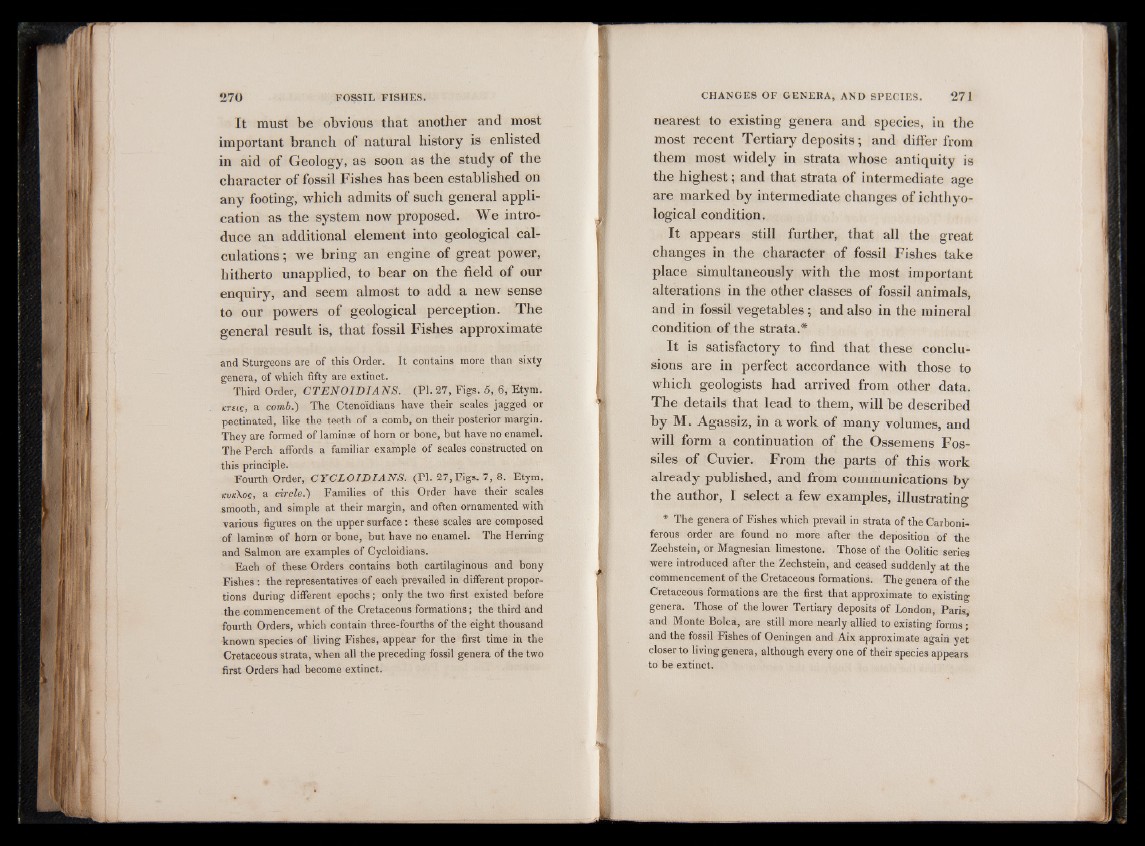
It must be obvious that another and most
important branch of natural history is enlisted
in aid of Geology, as soon as the study of the
character of fossil Fishes has been established on
any footing, which admits of such general application
as the system now proposed. We introduce
an additional element into geological calculations;
we bring an engine of great power,
hitherto unapplied, to bear on the field of our
enquiry, and seem almost to add a new sense
to our powers of geological perception. The
general result is, that fossil Fishes approximate
and Sturgeons are of this Order. It contains more than sixty
genera, of which fifty are extinct.
Third Order, CTENOIDIA NS. (PI. 27, Pigs. 5, 6, Etym.
ktciq, a comb.) The Cteno'idians have their scales jagged or
pectinated, like the teeth of a comb, on their posterior margin.
They are formed of laminae of horn or bone, but have no enamel.
The Perch affords a familiar example of scales constructed on
this principle.
Fourth Order, CYCLOIDIANS. (PI. 2 7 ,Figs. 7, 8. Etym.
kvkXoc, a circle.) Families of this Order have their scales
smooth, and simple at their margin, and often ornamented with
various figures on the upper surface: these scales are composed
of laminae of horn or bone, but have no enamel. The Herring
and Salmon are examples of Cycloidians.
Each of these Orders contains both cartilaginous and bony
Fishes : the representatives of each prevailed in different proportions
during different epochs; only the two first existed before
the commencement of the Cretaceous formations; the third and
fourth Orders, which contain three-fourths of the eight thousand
known species of living Fishes, appear for the first time in the
Cretaceous strata, when all the preceding fossil genera of the two
first Orders had become extinct.
nearest to existing genera and species, in the
most recent Tertiary deposits ; and differ from
them most widely in strata whose antiquity is
the highest ; and that strata of intermediate age
are marked by intermediate changes of ichthyological
condition.
It appears still further, that all the great
changes in the character of fossil Fishes take
place simultaneously with the most important
alterations in the other classes of fossil animals,
and in fossil vegetables ; and also in the mineral
condition of the strata.*
It is satisfactory to find that these conclusions
are in perfect accordance with those to
which geologists had arrived from other data.
The details that lead to them, will be described
by M. Agassiz, in a work of many volumes, and
will form a continuation of the Ossemens Fossiles
of Cuvier. From the parts of this work
already published, and from communications by
the author, I select a few examples, illustrating
* The genera of Fishes which prevail in strata of the Carboniferous
order are found no more after the deposition of the
Zechstein, or Magnesian limestone. Those of the Oolitic series
were introduced after the Zechstein, and ceased suddenly at the
commencement of the Cretaceous formations. The genera of the
Cretaceous formations are the first that approximate to existing
genera. Those of the lower Tertiary deposits of London, Paris,
and Monte Bolca, are still more nearly allied to existing forms ;
and the fossil Fishes of Oeningen and Aix approximate again yet
closer to living genera, although every one of their species appears
to be extinct.